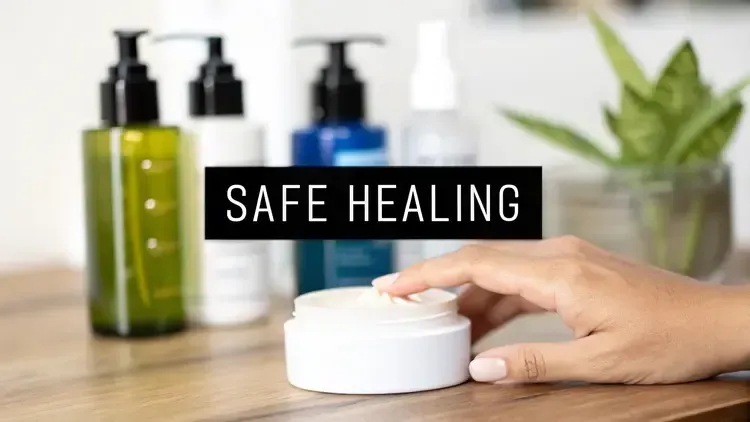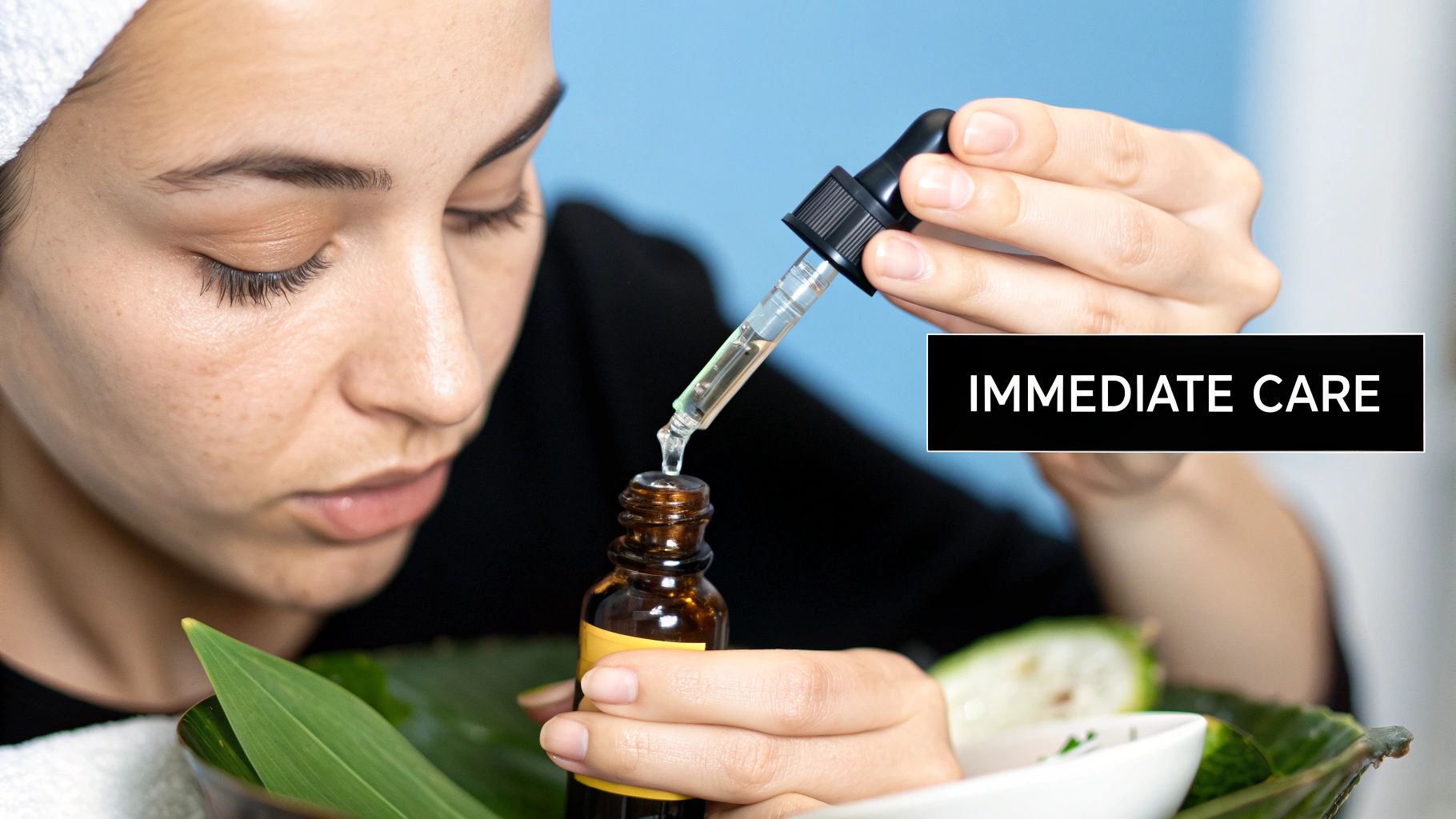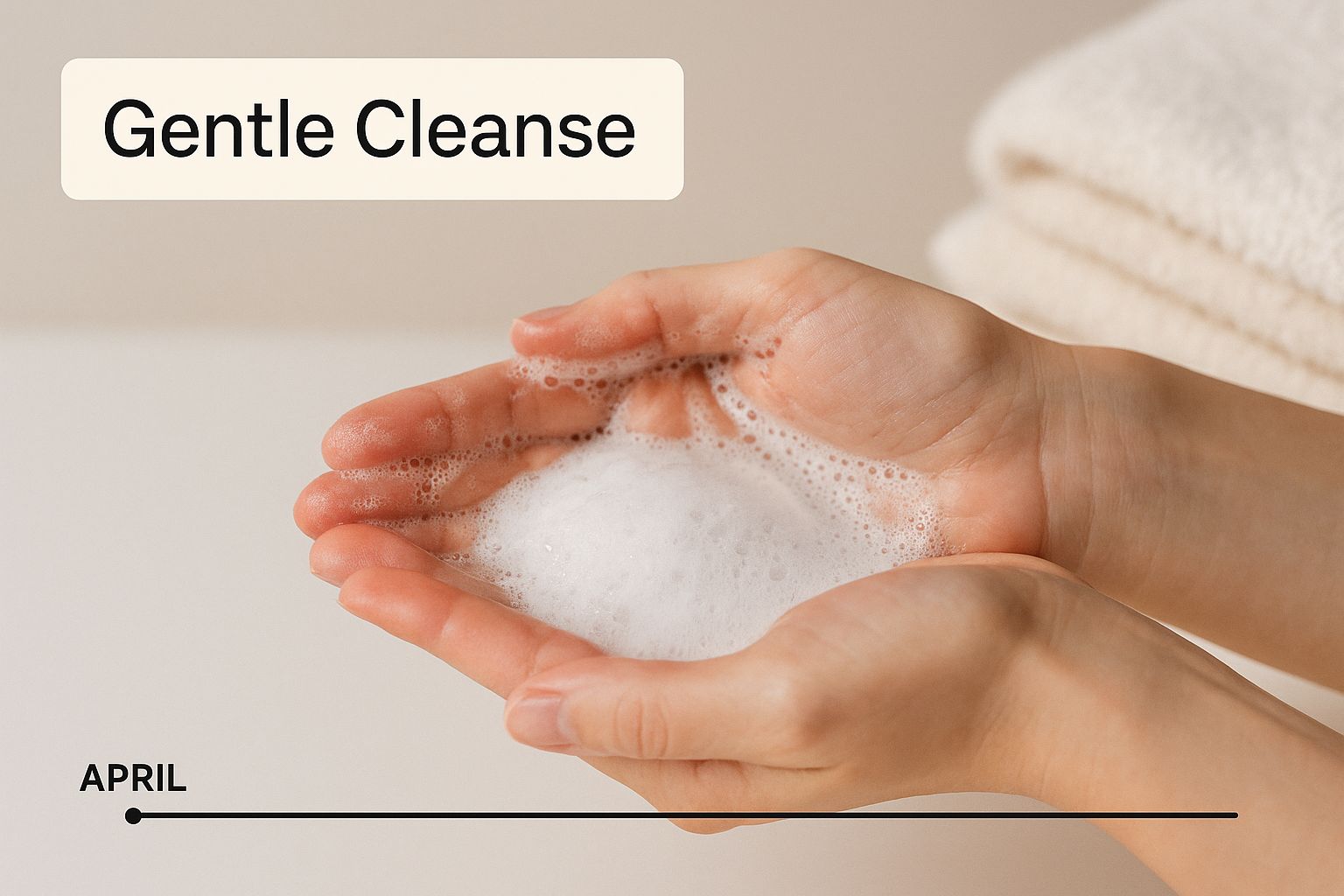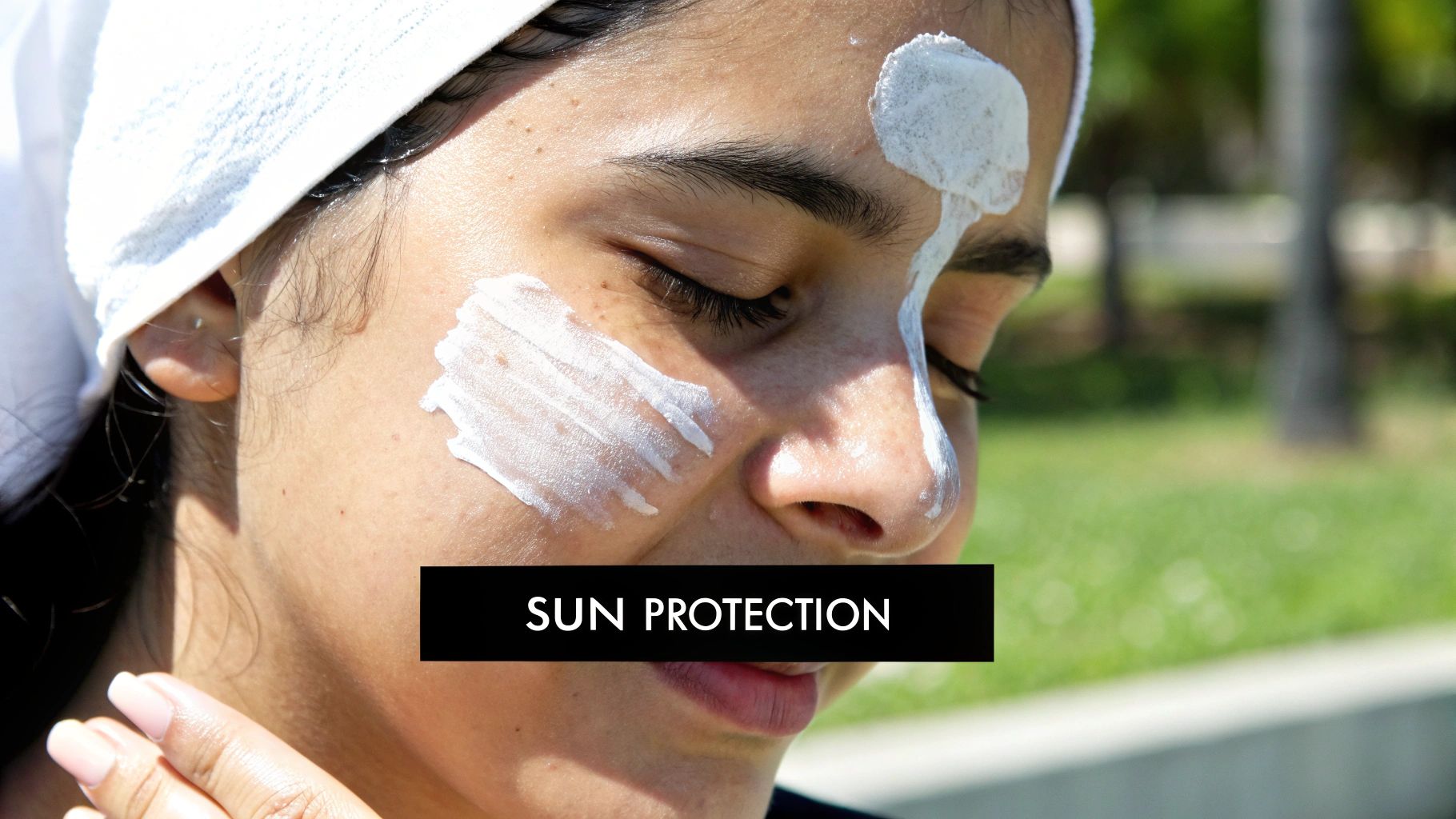
Chemical Peel Aftercare Instructions for Safe Healing
The first 24 hours after a chemical peel are absolutely critical. I always tell my clients that what they do immediately after leaving the clinic sets the entire tone for their healing process. The big three rules are simple but non-negotiable: stay out of the sun, slather on a gentle moisturizer, and whatever you do, do not pick at any flaking skin.
Following these instructions to the letter is your best defense against complications and the surest path to getting the glowing results you came for.
Your Immediate Post-Peel Game Plan

The moment your treatment is over, your aftercare journey begins. This first day is all about protecting your vulnerable, freshly treated skin. Think of it as a baby's skin—it needs gentle handling and a peaceful environment to heal, not a lot of prodding and poking.
What to Expect Right Away
It's completely normal for your skin to feel tight and look a little pink or even reddish, almost like you got a bit too much sun. The intensity of this reaction usually depends on how deep your peel was. This isn't a bad sign; it's a signal that the peel is doing its job and kicking off the cellular renewal process.
That feeling of tightness is just your skin’s initial response to the controlled injury we've created to stimulate new collagen and exfoliate old, damaged layers. It’s the first step toward the smoother, brighter skin hiding underneath.
The Critical Hands-Off Rule
If you remember one thing from me, let it be this: for the first 24 hours, keep your hands off your face. It's a simple rule, but it's the most important one. Your fingers are covered in oils and bacteria that can easily lead to breakouts or, worse, an infection on your compromised skin.
I know it’s tempting to touch or rub your face, but resist! A great little trick I share with my clients is to wear a soft headband to keep hair from tickling your face, which reduces the urge to touch it. Any friction is your enemy right now.
Expert Insight: Let your skin do its thing. Picking at peeling skin or scratching an itch can cause serious, long-term damage like post-inflammatory hyperpigmentation (those stubborn dark spots) or even permanent scars. This can completely reverse the benefits of the treatment you just invested in.
First 24 Hours Do's and Don'ts
To make things easy, I’ve put together a quick cheat sheet for navigating this initial, crucial healing window.
Here’s a simple breakdown of what to do and what to avoid at all costs.
What to Do What to Avoid Stay indoors and away from any direct sunlight. Touching, picking, or scratching your face. Period. Use a gentle, soap-free cleanser with cool water (if your provider advised it). Applying makeup or any active skincare products like retinoids or vitamin C. Sleep with your head propped up on an extra pillow to help minimize swelling. Strenuous exercise, saunas, steam rooms, or anything that makes you sweat. Drink plenty of water to hydrate your skin from the inside. Using rough towels on your face. Gently pat dry, always.
Sticking to these immediate guidelines creates the perfect healing bubble for your skin. If you're still in the planning stages of your treatment and want to feel fully prepared, you can always book a pre-peel consultation to go over a personalized plan. This ensures you’re protecting your investment and can start the recovery process with total confidence.
Navigating The Peeling and Healing Phase
Alright, this is where the real work begins—and where you’ll start to see the peel doing its job. Once that initial redness and tightness calm down, your skin will shift into the active healing phase. For most people, this means peeling. It’s crucial to understand what’s happening so you can handle it properly and get the beautiful results you’re after.
The Typical Healing Timeline
Don’t be surprised if you wake up around day two or three and notice some flaking. This is totally normal. Peeling almost always starts around the most mobile parts of your face, like the corners of your mouth and around your nose, before gradually spreading out toward your cheeks and forehead.
What you're seeing isn't just dryness. It's the old, damaged top layer of skin lifting away to reveal the fresh, healthy skin just waiting underneath.
The whole peeling show usually lasts between 3 to 7 days, but this really depends on the intensity of your peel. A light "lunchtime" peel might just give you some light, dusty flaking. A medium-depth peel, on the other hand, will likely cause more significant, sheet-like shedding. Try not to get caught up comparing your progress to photos online; everyone’s skin has its own unique schedule.
This is probably one of the most important things to remember during this stage:

As the visual shows, a gentle touch and the right products are everything. You’re protecting vulnerable, new skin, so be delicate.
Managing Tightness and Itchiness
As your skin gets to work building new cells and shedding the old ones, you’ll probably feel some tightness and maybe even some itching. It’s a good sign—it means you’re healing! But it can definitely be annoying.
Here’s the number one, non-negotiable rule: do not scratch or pick. I can't stress this enough. Pulling at peeling skin before it's ready to come off can lead to serious problems, like permanent scars or those stubborn dark spots known as post-inflammatory hyperpigmentation.
Instead of giving in to the itch, here’s what you can do to get some relief:
Cool Compresses: Soak a clean, soft washcloth in cool water, wring it out, and just gently press it onto the itchy areas. It provides instant relief.
A Soothing Moisturizer: A thin layer of a simple, bland moisturizer can work wonders for that tight feeling. I usually recommend products with ingredients like ceramides or hyaluronic acid that focus on barrier repair.
Patience: Just breathe and remember this part is temporary. The discomfort is a sign that your treatment is working exactly as it should.
Your goal right now is to keep your skin hydrated and calm without interfering. Let your skin shed on its own terms. If you try to speed things up by picking or scrubbing, you're only going to sabotage your results.
Your Daily Care Routine During Peeling
Your skincare routine needs to be stripped back to the absolute bare minimum. Think support and protection, nothing else.
Cleansing: Twice a day, use a soap-free, gentle cleanser with just cool water. Lather it up in your hands first, then use your fingertips to gently apply it. When you’re done, pat your face dry with a fresh, soft towel. No rubbing allowed.
Moisturizing: This is your new best friend. Apply a thin layer of a barrier-repair cream as often as you need it throughout the day. You want your skin to feel comfortable and hydrated, not greasy or suffocated.
Sun Protection: This is absolutely critical. You must apply a high-SPF, broad-spectrum mineral sunscreen (at least SPF 30) every single morning. Yes, even if it's cloudy and even if you’re staying inside by a window. Mineral-based sunscreens with zinc oxide or titanium dioxide are your best bet because they are much less likely to irritate your sensitive, healing skin.
I know that dealing with social events or work while your face is peeling can feel a bit awkward. If you’re worried about it, planning your peel right before a weekend can be a great strategy. Just remember, this phase is short. The incredible results, however, are long-lasting. If you need a little motivation, take a look at some of these chemical peel before and after results—they make the few days of downtime completely worth it.
Building Your Post-Peel Skincare Toolkit

Alright, let's talk about what you should—and absolutely should not—be putting on your face after a chemical peel. Your skin is incredibly delicate right now. It's essentially a brand-new surface that’s sensitive and highly receptive. The wrong product won't just sting a little; it can seriously derail your results by causing inflammation and irritation.
This is the time to strip your routine down to the bare essentials. All those potent serums and active ingredients you normally love? We're setting them aside for a bit. The focus now is on creating a gentle, soothing environment where your skin can heal without any interference.
Your Post-Peel Product Essentials
For the first week, your skincare shelf should look surprisingly sparse. You really only need three things to get through the peeling and healing phase safely.
A Soap-Free, Gentle Cleanser: Your everyday face wash is probably too much for your skin right now. You need something that cleanses without stripping away the natural oils your skin desperately needs. I always recommend creamy, non-foaming cleansers that are specifically labeled "gentle" or "soap-free."
A Barrier-Repair Moisturizer: This is going to be your best friend. A great post-peel moisturizer is intentionally bland—no fragrances, no acids, no retinoids. Look for ingredients like ceramides, hyaluronic acid, and glycerin. Their job is to hydrate and rebuild your skin's protective barrier. For intensely dry or tight spots, a simple occlusive like Aquaphor can be a lifesaver.
A Mineral-Based Sunscreen (SPF 30+): This is completely non-negotiable. Chemical sunscreens work by absorbing UV light and can sometimes irritate vulnerable skin. Mineral sunscreens, on the other hand, use zinc oxide or titanium dioxide to physically block the sun's rays, which is a much gentler approach. This is how you protect your investment.
Expert Tip: Less is truly more. For the first week, your entire routine should be cleanser, moisturizer, sunscreen. That's it. Anything else introduces a risk of irritation you just don't need to take.
The "Do Not Touch" List
What you avoid is just as critical as what you use. Applying the wrong product to freshly peeled skin is like adding fuel to a fire—it will cause stinging, redness, and can seriously mess with your healing process.
Hit pause on the following products until your aesthetician says it's safe, which is typically 7-14 days after your peel:
All Exfoliants: This means no physical scrubs and no chemical exfoliants like glycolic, lactic, or salicylic acid (AHAs/BHAs). The peel has already performed a deep exfoliation; more will only cause damage.
Retinoids: Park any product containing retinol, tretinoin (Retin-A), or adapalene. These ingredients speed up cell turnover, which is way too aggressive for skin that's trying to heal.
Vitamin C Serums: While vitamin C is a fantastic antioxidant for normal skin, its typically low pH can cause major stinging and irritation post-peel.
Cleansing Brushes & Tools: Put away any facial brushes, scrubbers, or even washcloths. Only use your clean fingertips to touch your face. Anything else can create tiny tears in the skin and lead to post-inflammatory hyperpigmentation.
I know reading ingredient labels can feel like a chore. To make it easier, we've gathered a collection of professional-grade products that are perfect for post-treatment skin. You can check out our aesthetician-approved options in our https://oliveskintherapy.com/products-list to find something you can trust.
Of course. Here is the rewritten section with a more natural, human-expert tone.
What to Do About Discomfort and How to Spot Trouble
Let's be honest, the healing phase after a chemical peel isn't always a walk in the park. A bit of tightness and some definite itching are totally normal – in fact, it's a sign that the peel did its job and your skin is starting its renewal process. But there’s a big difference between a little discomfort and a real problem.
Knowing how to handle the expected side effects will make your recovery a whole lot smoother. It also gives you the confidence to know when something isn't right and you need to pick up the phone.
Calming That Tight, Itchy Feeling
That stretched-out, can't-stop-thinking-about-it-itch usually kicks in around days three and four. It can be incredibly tempting to scratch or pick at the flaky skin, but please, don't. That's the fastest way to cause scarring or an infection.
Instead, here are a few tricks I've seen work wonders for my clients:
Gentle Cool Compresses: Grab a clean, super-soft washcloth, soak it in cool water, wring it out, and just lay it over the itchy spots. Don't rub. Just gently press for a few minutes. The relief is immediate and it won't damage your delicate new skin.
Sleep Propped Up: This one sounds simple, but it really helps. Use an extra pillow to elevate your head at night. This helps gravity drain excess fluid from your face, so you wake up with less puffiness and tightness.
A Light Mist (Use Sparingly): A quick spritz of a thermal water spray can feel amazing. It offers a little burst of hydration and calm. The key word here is sparingly. You don't want to keep the skin constantly wet.
My Two Cents: The goal here is comfort, not interference. You want to soothe your skin just enough to get by, but not smother it in heavy creams that could trap heat or block the natural peeling process. Let your skin do its thing.
When to Call Your Practitioner
The vast majority of peels heal perfectly fine, but you always need to be watching for signs of trouble. Knowing what isn't normal is just as important as knowing what is. If you see any of the following, don't wait—call your dermatologist or aesthetician right away. These could be signs of an infection or a bad reaction.
Keep an eye out for these red flags:
Signs of Infection: This includes any yellow or greenish crusting, blisters filled with pus, or any kind of foul smell.
Major Swelling: A little puffiness is normal. Swelling that's painful, feels extreme, or gets worse instead of better is not.
Serious Pain: Mild itching and tightness are expected. But if you're feeling a severe, throbbing pain or a burning that doesn't let up, that’s a warning sign.
Weird Color Changes: Pay attention to any extreme, raw-looking redness that resembles a burn. You should also watch for any new, patchy brown spots (hyperpigmentation) that pop up suddenly while you're still healing.
Remember, what you do matters just as much as what you put on your face. You absolutely must avoid any activity that makes you sweat heavily—think intense workouts, saunas, or steam rooms—until you are 100% healed. Sweat creates the perfect warm, moist environment for bacteria to thrive, which can lead to irritation or an infection that could derail your results. For an even deeper dive, the team at EternalDermatology.com has some great post-peel recovery insights.
At the end of the day, trust your instincts. If something just feels off or you're worried, a quick call to your provider is always the right move. They can either put your mind at ease or get you the help you need.
Keeping Your New Glow for the Long Haul
You've made it through the peeling and healing process—congratulations! Now you're enjoying that smoother, brighter skin you worked for. The real goal now is to protect your investment and make these gorgeous results stick around. This final phase is all about thoughtfully easing back into your normal skincare routine and adopting a few key habits to preserve that new glow.
The single most important thing you can do? Make sunscreen your best friend for life. Seriously. Your fresh, new skin is much more vulnerable to UV damage, which can reverse the benefits of your peel in a flash. You need to be using a broad-spectrum sunscreen with at least SPF 30 every single day. No exceptions. This isn't just for sunny beach days—it's for cloudy days, winter days, and even those days you spend working near a window.
Bringing Your Actives Back into the Mix
Once all the peeling and sensitivity are completely gone—usually after a week or two—you can start thinking about reintroducing your active skincare ingredients. The golden rule here is slow and steady wins the race. Your skin is still getting used to its new normal, so diving headfirst back into a high-powered routine is a recipe for irritation.
I always tell my clients to reintroduce just one product at a time. Use it only two or three nights a week to start, just to see how your skin reacts.
Gentle Acids: If you normally use a mild AHA like lactic acid, that's often a safe place to start.
Retinoids: These are the heavy hitters. They should be the very last thing you add back in. When you do, maybe start with a lower strength or use it less often than you did before the peel.
Vitamin C: This is a great one to bring back into your morning routine, right before you apply your mandatory sunscreen.
The most important thing is to listen to your skin. If you feel any stinging or see any new redness, back off immediately. Give your skin a few more days of TLC with just a gentle cleanser, moisturizer, and SPF.
Think Support, Not Challenge: Your goal is to maintain the beautiful results from your peel, not to see how much your skin can handle. A supportive routine will enhance your glow, while an aggressive one can easily shock your newly revealed skin.
Your Skincare Strategy for Lasting Radiance
Beyond diligent sunscreen use and a smart reintroduction of your favorite products, long-term success really comes down to consistency. It’s no surprise that treatments like chemical peels are becoming more popular everywhere. People want to maintain healthy, beautiful skin. Just look at the global trends—the chemical peel market in China is expected to grow at a CAGR of 4.2%, thanks to a huge focus on skincare aesthetics. Even in Japan, with its famously strict cosmetic regulations, the market is projected to grow by 4.0%. It’s clear that maintaining great skin is a worldwide priority, and you can read more about these global skincare trends to see the bigger picture.
Think of your chemical peel as a fantastic reset button. A consistent, protective daily routine is what locks in those results for the long term. Keep focusing on hydration, sun protection, and a balanced use of active ingredients, and you’ll keep your skin looking its absolute best for months, and even years, to come.
Your Chemical Peel Aftercare Questions, Answered
Even with the most detailed instructions, it's totally normal to have questions pop up as your skin starts to heal. Getting the right answers can make all the difference, helping you feel confident and calm during your recovery. Over the years, I've heard just about every question in the book, but a few come up time and time again.
Let's dive into what my clients most often ask me after they leave the treatment room.
When Can I Wear Makeup Again?
I get it. The temptation to cover up the redness and flaking is real, but this is where you have to be patient. Your skin needs to breathe.
You absolutely must wait until your skin has finished its entire peeling cycle, which typically takes about 5 to 7 days. Slathering makeup over skin that's actively shedding is a recipe for disaster. It can trigger major irritation, clog your brand-new pores, and even introduce bacteria, which could lead to nasty breakouts or an infection.
Once your skin feels smooth to the touch and the sensitivity has subsided, you can slowly reintroduce makeup. I always suggest starting with a light mineral powder. These formulas are much gentler and less likely to cause a reaction on your delicate, freshly revealed skin.
What Happens If I Accidentally Picked My Peeling Skin?
This is probably the biggest rule of chemical peel recovery: do not pick at your skin. It’s so tempting, I know, but you have to let your skin shed naturally, on its own timeline. When you pull off a flake that isn't ready, you're literally ripping away the protective barrier that's shielding the vulnerable new skin underneath.
Giving in to the urge to pick can cause some serious issues:
Raw, sore spots that take much longer to heal.
A much higher risk of bacterial infection.
Post-inflammatory hyperpigmentation—those stubborn dark spots that are so hard to get rid of.
Worst of all, you could cause permanent scarring.
Look, accidents happen. If you do mindlessly pick a spot, don't spiral. Just gently cleanse the area, dab on a simple barrier ointment like Aquaphor to protect it, and then make a serious commitment to keep your hands off your face. If the area becomes incredibly red or you see any signs of infection, call your provider right away.
My Two Cents: A chemical peel is supposed to reveal beautiful, healthy skin—not create new problems. Resisting the urge to pick is non-negotiable if you want the glowing results you paid for.
How Soon Can I Wash My Face After My Peel?
You can—and should—wash your face, but timing and technique are everything. Most people can wash their face a few hours after their appointment, or at the very latest, the next morning.
The "how" is what really matters. Use cool water only (hot water will feel awful and increase inflammation) and a super gentle, soap-free cleanser.
Lather the cleanser using only your fingertips in light, circular motions. Put away your washcloths, sponges, and—especially—your cleansing brushes. Anything abrasive is off-limits. When you’re done, very gently pat your skin completely dry with a clean, soft towel. No rubbing! Any friction can irritate your skin and prematurely lift flakes that aren't ready to come off.
At Olive Skin Therapy, we know that achieving beautiful skin is a partnership. Expert guidance is just as important as the treatment itself. If you’re ready to begin your journey to a clearer, more radiant complexion, we'd love to help. You can explore our customized treatments and book your appointment with us today.
